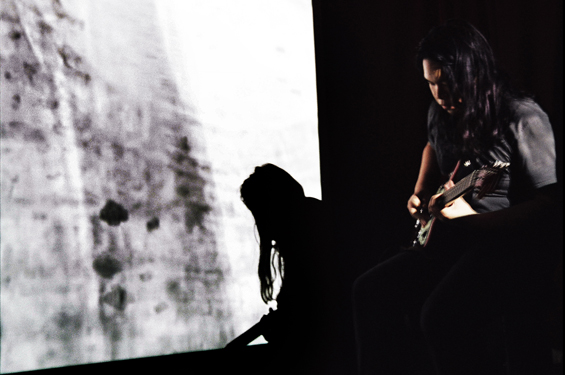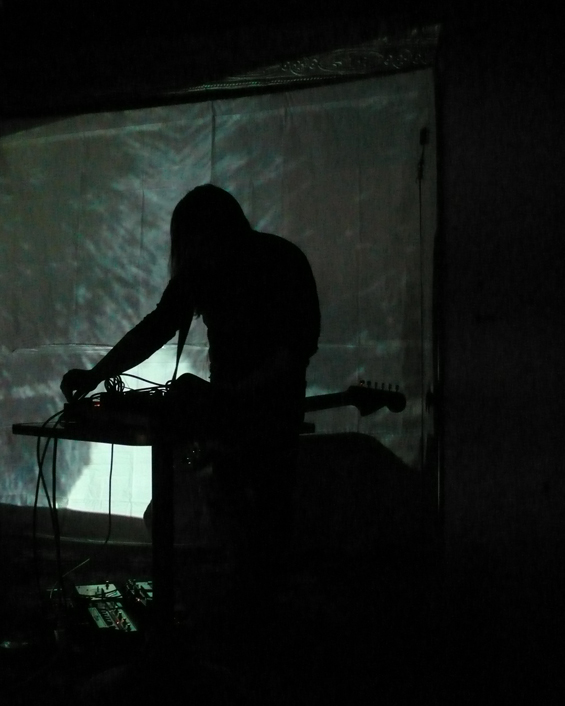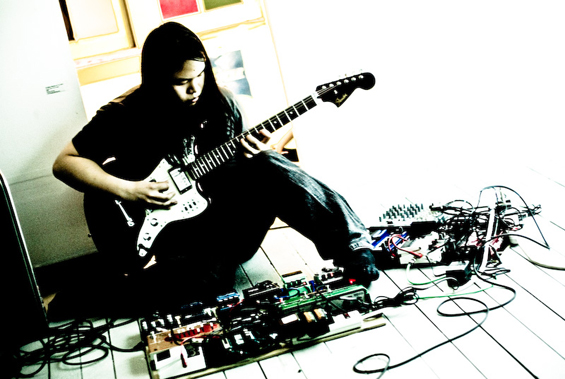Article
Ten Questions Eric Quach
Albums
Actress
Ellen Allien
The Alps
Aniline
Anodyne
Tommy Babin's Benzene
Maya Beiser
Pier Bucci
Budd & Wright
Celer
Ceremony
Richard Chartier
Deceptikon
Deepchord & Echospace
Marcel Dettmann
Dirac
Efdemin
GéNIA
Guillaume & C. Dumonts
Hammock
Helvacioglu & Boysen
Richard A Ingram
Inhabitants
Marsen Jules
Akira Kosemura
Manual
Dom Mino'
Teruyuki Nobuchika
Nono/ Wakabayashi
Olan Mill
Originalljudet
Fabio Orsi
M.Ostermeier
Rene Hell
Jeffrey Roden
J. Rogers
Roll The Dice
Secret Cities
Soundpool
Compilations / Mixes
Main Control Board
SEED X: Part I - III
EPs
Alternative Networks Vol. 2
Aural Diptych Series # 1
Aural Diptych Series # 2
Celer
Deerhoof vs OneOne
Filterwolf
Incite/
Ketem
Kogumaza
Yann Novak
Poratz
Quiroga
Repeat Orchestra
Sepalcure
Sub Loam
v4w.enko
The Zeitgeist EP
DVD
Stephen Vitiello

TEN QUESTIONS WITH ERIC QUACH (MAINS DE GIVRE / THISQUIETARMY)
These are busy times for Eric Quach. Already having built up an impressive body of work—full-lengths, singles, soundtracks, split releases, collaborations, and remixes—under the thisquietarmy guise, the Montreal-based artist is readying the release of his latest collection of effects-laden guitar-scapes, Aftermath. But it's hardly the only iron in his fire: concurrent with that release, Quach is issuing the debut album (textura's second label release) from Mains de Givre, his group project with violinist Émilie Livernois-Desroches, Esther Marie, as well as Aural Diptych Series # 1: Mains de Givre / thisquietarmy, a double three-inch disc recording on his own TQA Recordings label. Quach is also involved in numerous other projects, including Parallel Lines, a 'krautgaze' trio where he's joined by Ryan Ferguson on synths and Pascal Asselin on drums (the group's 38:22 is now available on Dead Pilot Records), and Ghidrah, a noise trio featuring thisquietarmy alongside Aun and Maggot Breeder. With so much going on, it's all the more impressive that Quach was able to find time to fill us in on the details surrounding these projects as well as others.
thisquietarmy: "The Hierarchy of Angels" (excerpt) (Aftermath, Basses Frequences)
1. One of the things that distinguishes the Mains de Givre sound is, needless to say, the central role the violin plays. The idea of surrounding the ‘human' cry of the violin with an immense field of effects and treatments seems like such a natural idea I'm surprised others in our current era didn't think to pursue it before you. Of course there are examples of related approaches—I'm thinking of Tony Conrad and even the King Crimson incarnation featuring David Cross—but it still seems like you've hit upon something novel in the Mains de Givre sound. Who might you see as precursors to Mains de Givre, if anyone?
We're surely not the first ones to explore this combination of ambient versus classical instrumentation; however, I think there is still a lot to be developed with that idea. Other related examples that stray further but that may be more related to our musical influences would be the likes of bands such as Esmerine, Rachel's, Dirty Three, Stars of the Lid, Godspeed You! Black Emperor, and Sigur Ros. Granted, these bands use classical string instruments to simulate drones, create crescendos, or emphasize the dramatic parts of their structured orchestral sound. But they also focus more on melodies, unlike some ambient artists that might use classical instruments in experimental ways that would be more linked to “musique concrete/actuelle” or electro-acoustic type—whereas we're rather aiming ourselves to create a cinematic and emotive type of music. Furthermore, combined with our personal style of playing and capacities, I think the result of this chemistry is what sets us apart as this “something new.”
2. Mains de Givre—frost hands—was a nickname given to Émilie Livernois-Desroches (émilie-aux-mains-de-givre) by her former bandmates so we know how Mains de Givre got its name. But why is the album titled Esther Marie? And for readers not fluent in French, could you clarify the meanings of the four track titles on the Esther Marie album?
Naming the band Mains de Givre was my idea; I liked its poetic ring. French being my first language, I somehow wanted an artistic vehicle to describe images in French since I rarely do it with thisquietarmy for some reasons. The titles were meant to be automatic abstract-types and were made up very spontaneously from visuals that popped inside my head while working on the tracks. Their rough translations are:
Un chœur d'âmes en détresse = A Choir of Mourning Souls
Le cercle des mœurs = Circle of Morals
Cauchemar en noir et rouge = Nightmare in Black and Red
Larmes sanglantes = Bloody Tears
Esther Marie is the name of the doll which graces the artwork of our album, and she belongs to Meryem Yildiz who did the photography for it. Naming an album from the artwork may seem unusual, but since the artwork fits perfectly with the mood of the album and the song titles, it felt right. Not only does it wrap the audio-visual works together, but it also adds an extra layer of abstract beauty to the end product.
3. I know that Esther Marie grew out of improvisations you did with Émilie. Can you take us through the process of how the album material developed? Were there hours of material that you re-visited which you then edited and shaped into the album's final form? What exactly happened?
At that point, we had several sessions recorded, and we initially wanted to combine the best of them together—only to quickly realize that it couldn't work out that way, stylistically. Each session had its own mood and identity, and so we decided to treat them separately. As a result, we focused intensively on the recording of our first-ever jam session, which was very basic: one guitar track and violin track. No overdubs, no extra arrangements, everything on the album is just a cleaned-up version of what we played that night, and in the same sequential order. It was just a matter of analyzing every single moment over and over to evaluate their presence in each movement, editing some parts out, and making everything sound as good as possible—basically 80% playback and 20% editing/mixing/mastering, which included duplicating and equalizing tracks, adding specific reverb to create a wider haunting sound field, and creating envelope volumes for each track to balance out both instruments.
4. How would you characterize the differences between the thisquietarmy and Mains de Givre styles?
Mains de Givre is still a very young project and so far, it's been 100% improvisation-based. The dynamic of two persons playing together is also very different, as opposed to thisquietarmy's looped-based style where I find myself playing against myself. In that sense, Mains de Givre's music is very spontaneous and created on the spot; we don't talk beforehand about what are going to do, nor have we tried to analyze where a certain piece of music should be heading, and I think it's a good thing for the time being. The songs structures are not at all worked out, tried out, or rehearsed in ways that thisquietarmy's usually are, either live or in studio. My playing is also more restraint, repetitive, and minimal in order to leave more space for the violin.
thisquietarmy is a much more personal endeavor and is more representative of myself as a whole. Stylistically, it started the same way as Mains de Givre, but it has become much more crafted, intrinsi,c and thought-through in general. It has already explored a lot of different directions by incorporating different types of arrangements, and the tracks are mostly composed and worked out in the studio.
5. Aftermath is your fourth full-length under the thisquietarmy name. Could you clarify how, if you think it has, the thisquietarmy sound has evolved over the course of those four albums?
I think each thisquietarmy record has always been about finding its own identity. It evolves in the sense that one work is different than the other, and how you have to push the boundaries of your creativity a little bit further every time and make the effort not to repeat yourself.
Sound-wise, thisquietarmy's initial agenda had been about trying to make captivating, active guitar ambient headphone music, and creating specific improv-based, short-length studio pieces (as represented on my early EPs) as opposed to exploring the overdone drone fields soundscapes. When I started to compose specifically for a live setting, I was trying to find ways to be creative on stage, and ended up developing all kinds of different tracks that were breaking out of that mould—which made up the first two albums, Unconquered and Blackhaunter. Transmissions was a conceptual soundtrack based on Christy Romanick's photography of the Very Large Array radio astronomy observatory, which was an entirely different process of creation altogether.
Aftermath is a bit of a return to the improv-based type of studio works, where I further explored the drone fields soundscapes that I initially tried to avoid, while incorporating elements of my previous works into them.

6. As a fairly detailed concept underlies Aftermath—the notion of a post-apocalyptic setting, fallen angels, and the possible dawn of a new era emerging from a post-nuclear winter—I'm wondering how much a given project develops in accordance with a concept formulated beforehand. Or is it more the case that the music develops first and as it does begins to suggest themes of one kind or another?
Unless a theme is pre-imposed, as in the case of Transmissions, the music usually develops first. It's a bit like a backward soundtrack as to me, the work in itself isn't complete until a visual concept emerges from these collection of tracks, and until titles are carefully picked to express the images that represent them. There are a lot of interactions that come between the music and its cinematic nature during the creative process; different arrangements can dictate different images and moods and vice-versa. I'm constantly thinking about how the music makes me feel as a listener, and thus imposing my own visual perspective of the music by tweaking with the arrangements.
7. Aftermath was inspired in part by the work of German artist Anselm Kiefer. How much inspiration for your work stems from outside influences such as visual art? What other things external to your music itself influence it?
Before I started making music, I did a lot of painting and visual works. The transition to using a guitar as a paintbrush and silence as a canvas was pretty natural to me. Visual works can stimulate the same kind of reactions you get from music, and that's why I've always linked sounds and images together. The inspiration I got from Kiefer's powerful works was mostly about the way I identified with its desolate, raw, earthy, destructive, depressive, and symbolic representations.

Anselm Kiefer: Deutschlands Geisteshelden (Germany's Spiritual Heroes), 1973
In the same way, I'll be directly inspired by my surroundings, occurring events, or feelings that generate similar representations—as much on a global level (wars, natural catastrophes, tragedies, etc.) as on a personal level (relationships, everyday life, work, etc.). Having studied in a scientific domain at university level and having worked in the engineering field for the last 10 years, I'm also influenced by my own perspective on the corporate and material world, its links with the economy, politics, and how it affects society in general—while being an artist at the same time. Also, being raised with little artistic upbringing by hard-working immigrants, middle-class expectations, and bi-cultural identity—all in all, having this somewhat unique perspective and lifestyle can sometimes lead to loneliness and it does translate a lot into the way I express myself artistically.
8. You've no doubt been exposed throughout your life to a wealth of music by other guitar players. Who are some of your major influences and who made a major impact on you as a developing musician?
I've always been attracted to bands with interesting guitar sounds or guitars that didn't sound like guitars, even before I got into the whole shoegaze and post-rock scene. The introspective playing of Slowdive, My Bloody Valentine, and Godspeed You! Black Emperor were probably big reasons why I experimented with many effects together.
Scott Cortez from lovesliescrushing is another huge influence of mine for guitar sounds and experimental guitar philosophy. Those ‘no spaces between words' band names of mine are actually tributes in respect to lovesliescrushing. I also got the chance to collaborate with Scott Cortez a few months ago, and our album will be released on twelve-vinyl by the French-Swiss label three:four Records in June.
Playing in Destroyalldreamers really helped me develop as a guitar player as I'd only been playing guitar for two years when I founded the band.
Just playing and collaborating with other people in general,
especially Aidan Baker of Nadja, Jon Attwood of Yellow6, Patrick Lacharité of Below the Sea, and my friend Shane Whitbread who taught me a lot about effect pedals when I started out.
9. It may be nothing more than my skewed impression but it seems today like there is an ever-growing number of artists working with guitars and effects. How do you account for the phenomenon? Is it because someone like Fennesz made such a powerful statement in his work and showed how much potential a guitarist could have working in the experimental arena, or is it due to the instrument's capacity to bring forth such a personal signature?
The more people are doing it, the more people are exposed to that kind of sound and are influenced by it. In parallel, the availability of new technology targeting experimental players and the availability of software to play and record music make everything a lot easier. Then you have the internet that connects people to reveal and discuss tricks, secrets, techniques, and share their own work to just about anyone who wants to find it.
The challenge for the pioneering guitar experimentalist is to be one step ahead of the rest by trying to keep a fresh and original sound while surrounded by an up-and-coming lot of home-experimentalists that have access to newer, improved technology and probably have a better overview, as fans exposed to the genre, of what is currently being done and how.
10. Though thisquietarmy and Mains de Givre are your current focus, you also are involved in the group project Destroyalldreamers. What's its status? Finally, with new albums by thisquietarmy and Mains de Givre now being released, will you be touring to support them and if so where might we see you play and in what kind of configuration?
Destroyalldreamers is rather inactive at the moment. We've been having some commitment issues on top of logistical difficulties for the past couple of years. However, Shaun (drummer) and I have been working on and off on new ideas, and we have pieces and bits of demos here and there. We're still planning on recording a new album at some point, which will probably be a piece-by-piece studio album, as I don't think there is any concrete possibility of getting back together on a full-time basis and commiting to regular writing/jam sessions. Most of the songs we've recorded in the past have been the result of a full band jamming and inputting collectively… so we're having some trouble not being able to work that way anymore.
I also have a new tri-city project called Parallel Lines, with Pascal Asselin (Below The Sea, Millimetrik, Le Chat Blanc Orchestra) on drums and Ryan Ferguson on synthesizers (Sianspheric, Electroluminescent). We just put out our first recording on Dead Pilot Records, and we have plans to get together again to record more jams. I also have a power-drone/noise project called Ghidrah with Martin Dumais of Aun and Reuel Ordoñez of Maggot Breeder; we've performed live quite a few times already—and I sometimes perform live under the moniker "hi my quiet tsar" with an analog synthesizer and pedals.
thisquietarmy has always been a one-man live multimedia band, with real-time guitar looping and projected visuals that are specifically re-done for almost every set. Mains de Givre would have the same configuration (although no specific visuals) plus Émilie on violin. It might be an interesting possibility to combine both projects as one show if I were to tour with both projects at the same time.
We only have very short-terms gigging plans for now. In support of new releases, thisquietarmy will be playing with Grouper as part of the Suoni Per Il Popolo festival on June 8th, and Mains de Givre will be playing on May 20th with some local friends—both shows in Montreal. I've had a few invitations for shows in southern Ontario, as well as in Vermont, NY and Massachusetts; we'll see about those when it gets more concrete.
I'm in between jobs at the moment, and won't be able to support myself with music only, so I can't really plan any extensive touring before I figure out that situation. I'd also like to see what kind of attention both records will receive in order to assess the interest for sustainable shows outside of our hometown. I'd love to go back to play in Europe this year (for either or both projects); the three-week tour I did last year with Nadja / Aidan Baker was a great experience, and one I'd definitely love to do again.

June 2010
ERIC QUACH
MAINS DE GIVRE
THISQUIETARMY
![]()